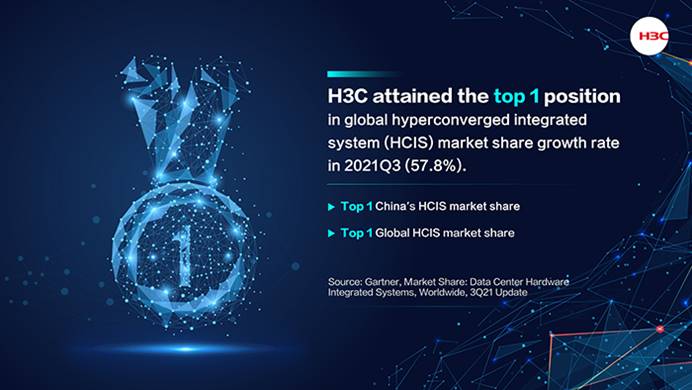57.8%! H3C Logs Highest Market Share Growth of Global HCIS Market in Q3 of 2021: Gartner Report
H3C’s share in global hyperconverged integrated system (HCIS) market grew by 57.8% during the third quarter of 2021, the fastest among HCIS vendors, according to a recent report released by Gartner titled “Market Share: Data Center Hardware Integrated Systems, Worldwide, 3Q21 Update”.
H3C’s share in the global HCIS market ranked second in the world and first among those of Chinese companies in the market, retaining its No.1 ranking in China since last year, suggested the report.

Lossless Architecture Drives Continuous Improvement of H3C’s HCI Products
In the era of digital economy, mass data have reshaped the basic IT architecture, requiring it to be adaptable and extensible enough in order to rapidly respond to changes of innovative technologies. Meanwhile, HCI, a core product of basic IT architecture, must be cloud and AI native.
However, traditional HCI solutions have been faced with plenty of challenges, including high system resource usage, poor network software forwarding performance, excessive CPU resource consumption by value-added services, as well as storage device’s low IOPS (input/output operations per second), latency, and preemption of CPU resources.
H3C’s latest HCI UIS 7.0, which adopts cloud and AI native architecture, is able to satisfy customers’ diverse demands for deployment with its five core engines. It has changed the form of traditional hyperconverged systems and can provide multi-role cluster capabilities, thus enabling hyper-converged resources to be freely coordinated and combined like blocks and meeting customers’ needs in asymmetric business scenarios and expansion for nonlinear systems.
H3C’s UIS 2000 G3 HCI Helps SMEs Move onto Cloud for Low-carbon Development
H3C’s latest UIS 2000 G3 HCI series, equipped with UIS 7.0 software, integrates computing, storage, networking and security capabilities, and can enable SME to build data centers easily.
With a lightweight design, it provides dual-node dual-route UIS and up to a dozen of hot swappable hard drives in a 2U space, thereby further improving the computing density. One single set of the UIS 2000 G3 HCI can create a complete cluster. Besides, it can be used to build cluster with an odd number of nodes with other UIS products and support horizontal expansion. UIS 2000 G3 HCI enables customers to build dual-node HCI cluster at the cost of traditional single-node HCI, significantly reduce their deployment costs.
H3C UIS 2000 G3 HCI can function in business scenarios of enterprises with a workforce ranging from dozens of employees to over one thousand people. A 3-node or 4-node cluster solution can meet the needsof enterprises with over a thousand employees and less than 30 business application scenarios.
Data centers using computing virtualization technology can reduce their energy consumption by 20% to 80% compared with that of data centers with traditional architecture; and data centers that adopt the hyper-converged architecture and UIS 2000 G3 HCI can realize another 30% reduction in energy consumption, helping customers accelerate the realization of carbon neutrality.
H3C’s HCI UIS 7.0 solution can bring IT architecture to the cloud and AI native era by meeting customers’ various needs in the process of digital transformation, regardless of stage, scale, location, scenario and form. The company believes that by continuously leveraging superior technologies, HCI is bound to become the key to success for digital transformation in various industries.

